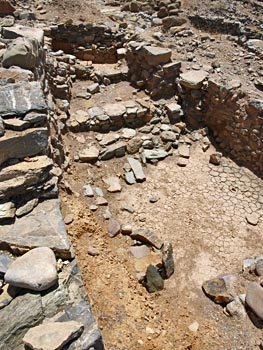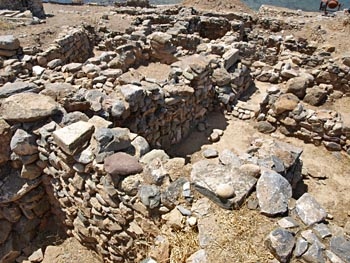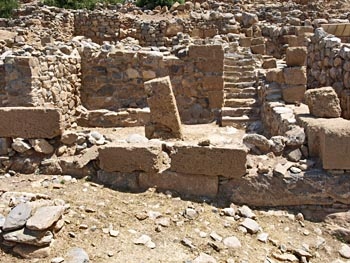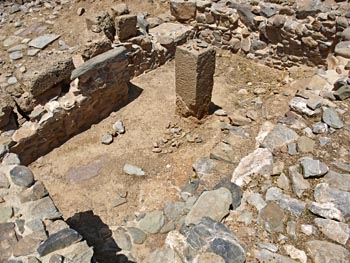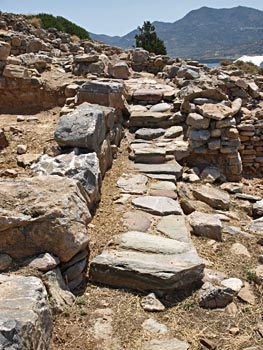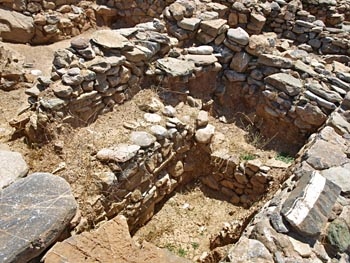Mochlos settlement
Three prepalatial houses
Prepalatial House 1. In Block C a prepalatial house was discovered directly beneath a LM I street. Parts of its walls had been reused as cobbles in the street. The house had been destroyed along its south side by beach erosion and the east and west sections had facades of LM I houses built on top. The building was almost ten metres wide from east-west. In the north section there were three rooms. Room 1 was the central room and had a paved floor while room 2 to its east had a small square area divided off in the north west corner. This area had five different floor levels full of carbon and fragments of baking plates, and seems to have been a cooking area.
Room 3, west of the central room, was very small and its north wall remained unexcavated beneath house C.1. The floor was destroyed by later LM I occupation. A fourth room, which may belong to a different house, was built against the eastern wall of the prepalatial house at a later time. Just east of a neopalatial wall that runs down the east side of this room a closed EM IIB deposit was found which probably belongs to this room.
The earliest room, the eastern room, had five different floor levels. The greatest concentration of finds came from the uppermost floor level in the eastern room where 18 stone tools were found including hammer stones, fishing weights and obsidian blades. Most of the pottery was unpainted ware from the Prepalatial period. Some EM II and EM III sherds were found in the streets to the west and north of the house so it was in use during both these phases. A hearth was also found dating to the Protopalatial period.
Prepalatial House 2. Only parts of three rooms and a few walls survive. The house was found below neopalatial building B.2. The walls of this later building go down into the earlier building on the west and east. In fact the existence of the EM building may account for an indentation in the south facade of B.2. It seems the neopalatial builders built their walls around the EM structure which left a gap of over five metres in the south facade where the EM house was located, a gap with a depth of up to four metres North to South.
Part of the south facade of the prepalatial building is still preserved running east to west inside this indentation between the two later walls of B2. Part of the north rear wall of the EM building survives behind room 3.
Room 1 of the EM house was a long narrow room which was later divided by wall. The eastern part had long gone but the north-south length of the room is 3.40 metres. A small stone bench was discovered in the southwest corner. Two very small western rooms are completely preserved. Room 2 is only 1m x 2.30 m while Room 3 is only 1m x 2.60 m.
According to the excavators, the building actually resembles many of the tombs in prepalatial cemetery. Like many of those tombs Prepalatial house 2 was built of mud brick on a rubble base.
In Room 1 two distinct floor levels were uncovered. On the higher of the two floors a Vasiliki Ware jug and stone tools were found. The lower floor level was originally paved with green schist slabs. Finds included a pyxis and pieces of EM IIA goblets. Room 2 was very similar to room 1. Just outside the west wall of the EM house pottery from EM I to EM IIB was found in a disturbed deposit. It may belong to another room in the house which had been ruined by later LM I construction. The room was probably dated to EM IIA.
Prepalatial House 3. This house lies beneath the alley that runs along the east side of house C3 and beneath house C7 that lies to its north and east. This building differs from other prepalatial buildings in its construction and the large quantity of EM III pottery. The walls are much more carefully built and more massive than the walls in the other prepalatial houses. At almost one metre wide, they could have supported a second storey.
Protopalatial houses
There was a sharp decrease in the number of burials in the cemetery during MM IA at end of the prepalatial period and none of Seager's pottery finds date to MM IB. The settlement appears to have fallen into decline and suffered a drop in population. But we know from some MM IB finds, including at tomb Λ (Lambda), that the island was not abandoned. In 1989 some MM IB-MM II pottery was found mixed with pottery of several periods in the fill beneath the floor of rooms west of Block D but from the southernmost part of Block C comes evidence in the form of a hearth. The semicircular hearth was built with stones lined with clay. It was found beneath the LM I square separating House C1 from C5. In Protopalatial times the hearth would have been in the open air and may have been used for smelting since a small piece of bronze slag was found inside it.
Then in 1991 a MM deposit was found beneath the Middle Minoan III/LM IA foundation level of room 2.3 in neopalatial house C3. It may belong to an upper storey collapse of a protopaltial house which was largely destroyed when house C.3 was built. It is thought that the finds date to a late stage of the protopalatial period because of the MM III/LM IA material found immediately above. So far no continuous sequence of old and new palace pottery has been found at Mochlos so there may have been a break in occupation of the settlement that lasted a long time. However, features of the pottery that was found point to late MM II.
The LM IB town
Seager excavated four blocks of LM I houses along the south coast of the island and he named them Blocks A, B, C and D. Each block was separated from neighbouring blocks by a narrow alleyway. He didn't name any individual houses. Blocks A, B, and C are found to the west of the chapel and block D to its east. Only block D was described and drawn by Seager. Soles and Davaras gave numbers to the houses in each block they excavated and numbers to each room. These numbers start with 1, 2 or 3 depending on the level the room belonged to. So room 1 on the first (ground) floor was called 1.1 and room 1 on the second floor was 2.1. Many of the houses were built on terraces to take acount of the slope of the hill on which they were built
When excavating these houses archaeologists time and again came across the same scene. There would often be two floor levels on the ground floor, the lower made of green schist slabs, with a later level of white clay on top. Because the upper floor and the roof collapsed before the walls fell in, they would then find rubble from the second floor (upper floor) if there was one, on top of which were the remains of any objects that had been on that floor at the time it collapsed. On top of that the next layer would be from the roof of the building and on top of that any rubble that had fallen in from the walls of the building as they collapsed inwards. It isn't possible to describe all the houses in all the blocks here but one house in particular deserves a lengthy treatment.
Block B House B2
Seager considered Block B to be single large house. In fact there is more than one building to Block B but House B2 is by far the largest structure in the block and probably the most important building in the town. It has been described as a civic centre.
Excavators identified B2 as the central building of the site because of its monumental ashlar masonry facades, the only such facades found on the island, and because of evidence for ritual activity in the room with a column above the east pillar crypt (described below). B2 extended the whole width of Block B and up three terraces so it was at least three stories high. The north end of each storey was preserved due to the terracing, while the second and third floors at the south end of the building collapsed onto the first (ground) floor during the destruction.
The central section of B2 was destroyed by a Hellenistic building but it seems there were two wings projecting towards the south on either side of a large gap in the middle of the south facade. These two wings were separated from each other on the first (ground) floor but were joined on the second and third floors.
The first (ground) floor of the East Wing. Room 1.1, a pillar crypt, was discovered on the first (ground) floor in the south east corner of the building. Finds included the head of a female figurine, half a clay boat, parts of two large strainers decorated in LM IB style, part of a rhyton and some loom weights.
All these had fallen from a room above the pillar crypt. This room had had a central column, probably made of wood, that had been placed immediately above the pillar in the pillar crypt. The floor of this second floor room had been paved and its walls had been decorated. It formed the southern half of a Minoan Hall, with room 2.2 on the second terrace forming the northern half. The finds suggest it served as a shrine like many other upper rooms with columns. The pillar crypt itself had a bench in the northwest corner of the room and a pillar near the centre of the room. The north wall of the room has been preserved to its original height. A large window in the east wall of the room overlooked the alleyway. There was a staircase in the northeast corner of the room with 13 perfectly preserved steps leading to a landing on the upper floor with access to room 2.2.
A second pillar crypt was found immediately to the west of the eastern crypt on the first level of the building. As with the eastern crypt the upper storey collapse was still preserved. Many pieces of red wall plaster were scattered throughout the debris, showing that the walls of the room with columns above the west crypt had been painted like those above the east crypt. At the bottom of the collapse debris, a marine style vessel was found.
The west pillar crypt was linked to the eastern crypt via a door at its southeast corner. A pillar, still upright, was found standing on a base of green schist. A long narrow bench ran along entire north side of the room. The west crypt also had a window. Finds were limited to one conical cup and a stone pestle.
There was no direct access to the pillar crypts from outside. Access was instead from a staircase down from the level above (already mentioned). In the area outside the pillar crypts conical cups which had been used as lamps were found. It may be that the pillar crypts were the site of ceremonial activity during which people lit lamps and placed them in front of the two pillar shrines. Further excavation work reached the bedrock but nothing was found earlier than LM IB which is when this wing of building B2 with its ashlar facades appears to have been built.
The second floor, East Wing. On the second floor of the east wing, a large threshold stone in the east facade marks the main entrance to House B2. Outside the entrance, the street running north to south along the east facade of the building was met by the street running east to west between buildings C.3 and C.6 so the entrance could be approached from three directions (north, south and east). The entrance opens into a rectangular vestibule, room 2.1. This room was divided into two and opposite the entrance was part of the original ground rock which had deliberately not been levelled off. Room 2.1 led into room 2.2.
Room 2.2 was paved with green schist slabs and had two column bases located towards the middle of the room, one of which is missing. The room measured 3.57 x 5.70 metres and was surrounded by six or seven doorways, five of them with ashlar jamb bases. There were three doorways in the west wall alone. The northernmost one opened onto a narrow corridor which led to the interior of the building and to an interior staircase to the third level. There must have been one or two doors in the destroyed south wall of this room which would have opened into the now destroyed room with the column above the east pillar crypt on the first (ground) floor. Another door in the east wall opened onto the landing and stairs down to the pillar crypt mentioned above.
The focus of room 2.2 was a large basin located in the floor at the north side. Two wooden columns stood here on stone bases on either side of a triangular slab of purple schist, marked with the shallow hollows of a kernos and they framed the view into the basin, which was a rectangular, slightly sunken area, lined with plaster. The basin measured 1.25 x 2.00 x .0.5-0.40 m. It was intended to hold water as a drain opened off the southeast corner. LM IB cups, from the period of destruction, were found in the drain.
There is evidence of two periods of use for this room, with the schist floor being covered with a white plaster floor at a later date. A circular schist slab had been placed as a column base on top of this plaster towards the southwest and stood in line with the western of the two stone column bases on either side of the basin. In the second phase the corridor leading off the northwest corner towards the staircase to the upper level was blocked with a wall so a new, more circuitous route had to be taken through a long narrow corridor to reach the staircase and other rooms in the interior on the second level.
Room 2.3 on the second level to the west of room 2.2 has been all but been destroyed but we know it was entered via a corridor which ran from the room wiht columns above the west crypt past the interior staircase to level three and on to the entrance to room 2.3. A cylinder seal of green serpentine was found just inside the doorway to the corridor. Room 2.4 was a small side room to room 2.3 and it contained a large number of animal bones, a hearth in the northwest corner, a stone mortar, a brazier and other tools associated with the preparation of food. Two more floor surfaces below the floor had both also been used for cooking. Among finds were mortars, cups, bowls, and a quern. Since room 2.4 communicated directly with room 2.3 excavators consider that room 2.3 may have been a dining room.
Ashlar masonry from the east wing of House 2B had fallen into Room 3 in building C.3 to the east and onto the alleyway that divided block B from Block C at this point. Ashlar blocks from B.2 were also found as far away as 8 metres to the east, along the south facade of House C.3. indicating that they had been hurled with considerable force.
The West Wing. The West Wing of building B2 had been built entirely with rubble rather than ashlar masonry. A street runs along the west facade of the West Wing and separates Block A from Block B. Much of the west facade of the West Wing had fallen into this street during the destruction. It is from a small court, paved with cobbles, next to this street that the West Wing was entered. The entrance from the court into the building itself leads into a long narrow corridor, also paved.
South of this corridor there are several rooms on the first (ground) floor on the same level as the pillar crypts in the East Wing. The largest room, 1.3, in the southwest corner of the building, was partially paved with slabs and there was a large stone bench positioned against the north wall. The corridor giving access to this room also gave access to two small storerooms on the north and a small square room (1.4.) on the south. In 1.4 six large bronze basins were found. They were arranged in three pairs, each with one basin inside another.
There was a basement beneath room 1.3, accessed by a stairwell which originally would have had wooden steps. On the bedrock, the skull of a young woman was found. The woman had been killed by a blow to the head.

